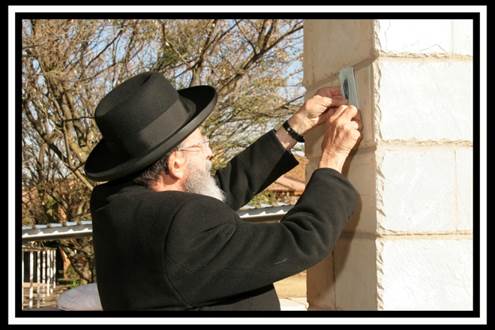At Home with the Mezuzah
(Mostly from my book, Gateway to Judaism)
Now that I have been at home for over a week, teaching via Zoom, communicating via WhatsApp, not negotiating the traffic on the George Washington Bridge, I have had the time to look around our house. The symbol that looks back at me from virtually every door is the mezuzah. So, I thought it would be relevant to offer a few ideas about the ubiquitous symbol of the Jewish home, the mezuzah. The word mezuzah, literally means doorpost. Common usage of the term, however, refers to the parchments that are attached to the doorpost. The two paragraphs of Shma – a Biblical quotation affirming the Oneness of God — are written on a parchment, placed in a container and affixed to the right doorpost of every door in the house. Throughout the world and throughout history, mezuzot (pl.) have adorned and identified Jewish homes. Mezuzot have been found in Qumran, Israel dating back about 2,000 years. In the Old City of Jerusalem, rather than attaching the mezuzah onto the doorpost, a niche was typically carved into the Jerusalem-stone of the house doorpost and the parchment placed directly inside. In the “Moslem Quarter” of the Old City, one can still identify former Jewish homes by the presence of a stone with a carved out niche in the doorframe.
Volumes could be written on the rich history of the mezuzah, from an artistic, historical and sociological perspective. Artists have designed beautiful mezuzah cases of sterling silver, marble, glass, wood and leather. In a kibbutz in the north of Israel, a farmer who works in the olive groves carves cases out of the olivewood that he cultivates. Mezuzot abound with the designs of renowned artists such as Marc Chagall and Ron Agam. From Singapore to San Francisco, Jewish homes are identified by the mezuzah on the door. The outer case is only a container, however. The true essence of the mezuzah lies within contained in the words of Shma, so carefully written on the parchment.
An acquaintance of mine, the principal of a Jewish high school in California, once noticed a captain in the United States Navy saying Kaddish at a local synagogue. He greeted the officer, introduced himself, and in due course, learned that the captain was the commander of a nuclear aircraft carrier that has just come into port. Naturally, he asked if he could bring his students to tour the aircraft carrier and after some (ok, a lot of) nagging, the captain agreed. As a gesture of appreciation, the principal decided to bring a mezuzah in a beautiful sterling silver case for the officer’s personal cabin. After the tour, the students presented the mezuzah to the captain. But they were keenly disappointed to hear that it was against Navy regulations to attach anything unofficial to the vessel. When the captain saw how upset the students were, he phoned the admiral of the fleet to request permission to put up the mezuzah. The admiral agreed, on condition that they paint it battleship-gray. The mezuzah was set in place to everyone’s satisfaction. Even when it is no longer an object d’art, the mezuzah’s spiritual beauty and effect remain untouched.
Inside the Mezuzah
“…Write them [these words] on the doorposts (mezuzot) of your house and upon your gates.”
The phrasing of the Torah commandment suggests that the words of Shma be inscribed on the house itself, carved into its stones and bricks. Since the Torah also specifies that the writing must be clear and precise, however, the Oral Tradition tells us that we are to write the paragraphs on parchments, which are then affixed to the doorpost. The Torah presents the commandment in this way to teach us that the effect of attaching a mezuzah to a doorpost is to transform the entire house into an object of holiness.
The parchments are written by a scribe, with special ink, in Ktav Ashurit, a specific Hebrew lettering style used exclusively for the Torah, tefillin and mezuzah. Even a slight flaw in the writing will render the mezuzah unfit for use. We can appreciate this need for precision by considering the production of computer chips, where even the slightest error can make them useless. The verses must be transcribed exactly as they appear in the Torah. Because the Torah is the word of God — whose perfection means that He is also completely efficient — every word, every letter and even the very shapes of the letters convey meaning and have significance.
Home Security System
Jewish tradition teaches that in the merit of the mezuzah God protects our houses. How does this happen? There is no magic involved, and the explanation is relatively simple. Because the degree of God’s involvement in our lives is directly proportional to the degree that we are conscious and aware of Him, the more that we are reminded of God’s presence, the more of His presence we will experience. The mezuzah is a vital element in creating and maintaining that awareness — and Divine protection is the result.
The Talmud states that the mezuzah also protects individuals from committing sin. Maimonides explains this idea:
… Every time a person enters or leaves his house [and notes the mezuzah on the doorpost], he will encounter the unity of the Name of the Holy One, blessed be He, and he will remember His love, and will wake up from his slumber and his obsession with the frivolities of the moment. He will realize that there is nothing that exists eternally except for the knowledge of the Rock of Ages. Immediately he will turn to contemplation [of the truth] and will walk in the path of the just. Our ancient Sages said, “Anyone who has tefillin on his head and arm, tzitzit on his clothing, and a mezuzah on his door, is assured that he will not sin” — for he has many reminders, and they [tefillin, tzitzit and mezuzah] are the very angels that save him from sinning — as it says, “The angel of God camps around the reverent ones and saves them.”
Home Hardware for the Heart
One obvious lesson that the mezuzah teaches is that we should build homes on which the words of the Torah are indeed inscribed. Through our activities, speech, hospitality and family life we can transform the house itself into a holy object. This may explain the Talmudic law which prohibits taking the mezuzah off of a house when leaving it. To do so would be tantamount to destroying a holy object.
The mezuzah serves as a constant reminder of key Jewish values. The two paragraphs inscribed on the parchment contain almost all of the most basic principles of Jewish belief. The first verse begins with the famous proclamation of God’s unity, Shma Yisrael, and continues with the ideas of love of God, the study of Torah, the fulfillment of the commandments, Divine providence and the concept of reward and punishment. The mezuzah reminds us of these ideas and increases our awareness of God’s presence in our lives. In order to remember the presence and significance of the mezuzah, it is customary to touch the mezuzah (some also kiss the fingers with which they touch the mezuzah, nowadays, we just blow a kiss) as one passes through a doorway.
Nachmanides points out that the text of the verses, the parchment, and the mezuzah’s position on the doorpost together encapsulates virtually all the major principles of the Torah. The parchment contains the words of Shma, the most fundamental statement of our faith in God. The mezuzah is placed on the doorpost, just as the Jewish people in Egypt placed the blood of the Passover Lamb on their doorposts, to show their allegiance to God and their devotion to His commandments. Nachmanides explains this idea beautifully in his commentary on the Torah:
…One who buys a mezuzah for one zuz, [Talmudic currency] sets it in his doorway, and thinks about its purpose has already acknowledged creation, God’s knowledge and involvement in the world, and also prophecy, and has declared belief in all the foundations of the Torah. In addition, he has acknowledged the great kindness of the Creator upon those who fulfill His will, whom He took from slavery to freedom…

